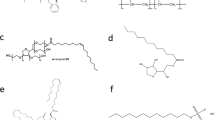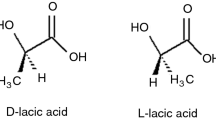Abstract
Polymeric dispersants with varying side chain lengths were prepared via solution polymerization, by using styrene and varying molecular weight of hydroxy polyethylene glycol methacrylate (HO-PEG-MA) as comonomers. The dispersants were used for the effective dispersion of organic pigment, e.g., C.I. Pigment Violet 23. Benzene ring was anchoring moiety while PEG chain was hydrophilic stabilizing moiety, in the dispersant structure design. The chemical structure and surface tension of dispersants were characterized, to correlate their relationship with result pigment preparation performance. It showed that longer side chain length could result in smaller particle size and stronger stabilizing effect. The theory calculations based on Derjaquin-Landau-Verwey-Overbeek indicated that longer side chain length dispersant provided higher steric stabilization energy, which was consistent with experimental results.
Graphical abstract









Similar content being viewed by others
References
Yuan J, Zhou S, Wu L, You B (2006) Organic pigment particles coated with titania via sol-gel process. J Phys Chem B 110:388–394. https://doi.org/10.1021/jp053938t
Lan Y, Lin J (2011) Clay-assisted dispersion of organic pigments in water. Dyes Pigments 90:21–27. https://doi.org/10.1016/j.dyepig.2010.11.007
Wang CX, Yin YJ, Fang KJ (2013) Investigation of gemini cationic water based pigment dispersion. Mater Res Innov 12:7–11. https://doi.org/10.1179/143307508x270749
Lee PTC, Chiu CW, Chang LY, Chou PY, Lee TM, Chang TY, Wu MT, Cheng WY, Kuo SW, Lin JJ (2014) Tailoring pigment dispersants with polyisobutylene twin-tail structures for electrowetting display application. ACS Appl Mater Inter 6:14345–14352. https://doi.org/10.1021/am503599k
Saindane P, Jagtap RN (2015) RAFT copolymerization of amphiphilic poly (ethyl acrylate-b-acrylic acid) as wetting and dispersing agents for water borne coating. Prog Org Coat 79:106–114. https://doi.org/10.1016/j.porgcoat.2014.07.016
Wijting WK, Laven J, van Benthem RATM, de With G (2008) Adsorption of ethoxylated styrene oxide and polyacrylic acid and mixtures there of on organic pigment. J Colloid Interface Sci 327:1–8. https://doi.org/10.1016/j.jcis.2008.08.021
Fabjan EŠ, Otoničar M, Gaberšček M, Škapin AS (2016) Surface protection of an organic pigment based on a modification using a mixed-micelle system. Dyes Pigments 127:100–109. https://doi.org/10.1016/j.dyepig.2015.12.016
Agbo C, Acheampong C, Zhang L, Lin M (2018) Preparing stable pigment dispersion utilizing polyoxyethylene lauryl ether as dispersant. Pigm Resin Technol 48:1–8. https://doi.org/10.1108/PRT-10-2017-0081
Acheampong C, Zhang L, Agbo C, Liang D, Du C, Fu S (2019) Synthesis and characterization of A-B-A-type nonionic dimeric dispersants for pigment dispersion. J Surfact Deterg 22:885–895. https://doi.org/10.1002/jsde.12279
Fu S, Zhang M, Xu C (2010) Preparation of a nanoscale color index pigment orange 13 styrene-maleic acid copolymer composite dispersion for ink jet printing. J Imaging Sci Technol 54:505–509. https://doi.org/10.2352/J.ImagingSci.Technol.2010.54.1.010505
Ran Q, Min Q, Liu J, Miao C (2012) SMA-g-MPEG comb-like polymer as a dispersant for Al2O3 suspensionsk. Appl Surf Sci 258:2447–2453. https://doi.org/10.1016/j.apsusc.2011.10.068
Li CC, Chang SJ, Wu CW, Chang CW, Yu RH (2017) Newly designed diblock dispersant for powder stabilization in water-based suspensions. J Colloid Interf Sci 506:180–187. https://doi.org/10.1016/j.jcis.2017.07.045
Agbo C, Acheampong C, Zhang L, Lin M, Wang D, Fu S (2019) Synthesis and application of novel dispersant using a dichlorotriazine azo moiety and Dodecan-1-ol. Prog Org Coat 127:1–7. https://doi.org/10.1016/j.porgcoat.2018.09.031
Ding Y, Ye M, Han A, Zang Y (2018) Preparation and characterization of encapsulated C.I. pigment yellow 12 via ball-milling and mini-emulsion polymerization. Prog Org Coat 117:69–75. https://doi.org/10.1016/j.porgcoat.2018.01.009
Zhang K, Ye M, Han A, Chen X (2020) Preparation and properties of styrene-btyl acrylate resin co-encapsulated pigment red 48:2 and oxidized polyethylene wax composite nanoparticles. J Appl Polym Sci 137:49150. https://doi.org/10.1002/app.49150
Fang T, Huo M, Wan Z, Chen H, Peng L, Liu L, Yuan J (2017) Study of structure–performance relationships of polymeric dispersants on particle dispersion and stabilization. Rsc Adv 7:2513–2519. https://doi.org/10.1039/c6ra25196j
Sis H, Birinci M (2014) Wetting and rheological characteristics of hydrophobic organic pigments in water in the presence of non-ionic surfactants. Colloid Surface A 455:58–66. https://doi.org/10.1016/j.colsurfa.2014.04.042
Kuo KH, Peng YH, Chiu WY, Don TM (2008) A novel dispersant for preparation of high loading and photosensitive carbon black dispersion. J Polym Sci Pol Chem 46:6185–6197. https://doi.org/10.1002/pola.22929
Chen YM, Hsu RS, Lin HS, Chang SJ, Chen SC, Lin JJ (2009) Synthesis of acrylic copolymers consisting of multiple amine pendants for dispersing pigment. J Colloid Interf Sci 334:42–49. https://doi.org/10.1016/j.jcis.2009.03.069
Faure B, Alvarez GS, Ahniyaz A, Villaluenga I, Berriozabal G, Miguel YRD, Bergstrom L (2013) Dispersion and surface functionalization of oxide nanoparticles for transparent photocatalytic and UV-protecting coatings and sunscreens. Sci Technol Adv Mater 14:301–304. https://doi.org/10.1088/1468-6996/14/2/023001
Liu W, Cheng L, Yao X, Fang R, Liu G (2016) Synthesis and properties of novel acrylic polyester hyper-dispersant. J Coat Technol Res 13:763–768. https://doi.org/10.1007/s11998-016-9787-3
Karlheinz H, Stefan M, Thomas L, Albert F (2013) Use of copolymers as adhesion promoters in lacquers. USP 8512465
Duivenvoorde FL, Laven J, Linde RVD (2001) Diblock copolymer dispersants in polyester powder coatings. Prog Org Coat 45:127–137. https://doi.org/10.1016/S0300-9440(02)00046-2
Yoon C, Choi JH (2008) Syntheses of polymeric dispersants for pigmented ink-jet inks. Color Technol 124:355–363. https://doi.org/10.1111/j.1478-4408.2008.00163.x
Tamasi M, Kosuri S, DiStefano J, Chapman R (2019) Automation of controlled/living radical polymerization. Adv Intell Syst 1900126:1–8. https://doi.org/10.1002/aisy.201900126
Chen YH, Chen SJ, Li JQ, Wu Z, Lee GH, Liu YH, Cheng WT, Yeh CY, Peng CH (2020) Cobalt(II) phenoxy-imine complexes in radical polymerization of vinyl acetate: the interplay of catalytic chain transfer and controlled/living radical polymerization. J Polym Sci 58:101–113. https://doi.org/10.1002/pol.20190301
Cunningham MF (2008) Controlled/living radical polymerization in aqueous dispersed systems. Prog Polym Sci 33:365–398. https://doi.org/10.1016/j.progpolymsci.2007.11.002
Luo X, Zhuang Y, Zhao X, Zhang M (2008) Controlled/living radical polymerization of styrene catalyzed by cobaltocene. Polymer 36:3457–3461. https://doi.org/10.1016/j.polymer.2008.05.035
Matyjaszewski K (2000) Controlled/living radical polymerization, progress in ATRP, NMP, and RAFT. J Am Chem Soc 768:4167–4171. https://doi.org/10.1021/ja908613x
Davis KA, Matyjaszewski K (2002) Statistical, gradient, block, and graft copolymers by controlled/living radical polymerizations. Adv Polym Sci. https://doi.org/10.1007/3-540-45806-9_1
Lutz JF, Neugebauer D, Matyjaszewski K (2003) Stereoblock copolymers and tacticity control in controlled/living radical polymerization. J Am Chem Soc 125:6986–6993. https://doi.org/10.1021/ja029517w
Braunecker WA, Matyjaszewski K (2007) Controlled/living radical polymerization: features, developments, and perspectives. Prog Polym Sci 32:93–146. https://doi.org/10.1016/j.progpolymsci.2006.11.002
Zhang X, Hu H (2014) Synthesis and application of a polyacrylate dispersant on the preparation of ultrafine ground calcium carbonate in a laboratory stirred media mill. Powder Technol 266:218–227. https://doi.org/10.1016/j.powtec.2014.06.037
Huang G, Pan Z, Wang Y (2018) Synthesis of sodium polyacrylate copolymers as water-based dispersants for ultrafine grinding of praseodymium zirconium silicate. Colloid Surface A 558:591–599. https://doi.org/10.1016/j.colsurfa.2018.08.027
Lokhande GP, Jagtap RN (2016) Design and synthesis of polymeric dispersant for water-borne paint by atom transfer radical polymerization. Des Monomers Polym 19:256–270. https://doi.org/10.1080/15685551.2015.1136534
Learner SQ, Learner T (2006) A review of the classes, structures, and methods of analysis of synthetic organic pigments. J Am Inst Conserv 45:107–125. https://doi.org/10.1179/019713606806112540
Nsib F, Ayed N, Chevalier Y (2007) Selection of dispersants for the dispersion of C.I. pigment violet 23 in organic medium. Dyes Pigments 74:133–140. https://doi.org/10.1016/j.dyepig.2006.01.047
Farrokhpay S (2009) A review of polymeric dispersant stabilisation of titania pigment. Adv Colloid Interfac 151:24–32. https://doi.org/10.1016/j.cis.2009.07.004
Henk HJWVD (1997) Design of pigment dispersants: methodology for selection of anchoring groups. J Coat Technol Res 69:137–142. https://doi.org/10.1007/BF02697764
Campos R, Cavaco-Paulo A, Andreaus J, Gubitz G (2000) Indigo-cellulase interactions. Text Res J 70:532–536. https://doi.org/10.1177/004051750007000610
Ozturk C, Kusefoglu SH (2010) New polymers from plant oil derivatives and styrene-maleic anhydride copolymers. J Appl Polym Sci 116:355–365. https://doi.org/10.1002/app.31609
Yossif NA, Kandile N, Abdelaziz M, Negm N (2017) Preparation and characterization of polymeric dispersants based on vegetable oils for printing ink application. Prog Org Coat 111:354–360. https://doi.org/10.1016/j.porgcoat.2017.06.005
Eleftherios A, Petrakis LR, Cagliani PA, Tarantilis MG, Polissiou RC (2017) Sudan dyes in adulterated saffron (crocus sativus l.): identification and quantification by 1H NMR. Food Chem 217:418–424. https://doi.org/10.1016/j.foodchem.2016.08.078
Xiao H, Zhao T, Li CH, Li MY (2017) Eco-friendly approaches for dyeing multiple type of fabrics with cationic reactive dyes. J Clean Prod 165:1499–1507. https://doi.org/10.1016/j.jclepro.2017.07.174
Shindy AH (2018) Structure and solvent effects on the electronic transitions of some novel furo/pyrazole cyanine dyes. Dyes Pigments 149:783–788. https://doi.org/10.1016/j.dyepig.2017.11.055
Xu C, Wang D, Wang H, Ma L, Zhu X, Zhu Y, Zhang Y, Liu F (2019) Experimental investigation of coal dust wetting ability of anionic surfactants with different structures. Process Saf Environ 121:69–76. https://doi.org/10.1016/j.psep.2018.10.010
Przadka A, Cabane B, Pagneux V, Maurel A, Petitjeans P (2012) Fourier transform profilometry for water waves: how to achieve clean water attenuation with diffusive reflection at the water surface. Exp Fluids 52:519–527. https://doi.org/10.1007/s00348-011-1240-x
Misra PK, Mishra BK, Somasundaran P (2005) Organization of amphiphiles: part iv characterization of the microstructure of the adsorbed layer of decylethoxylene nonyl phenol. Colloid Surface A 252:169–174. https://doi.org/10.1016/j.colsurfa.2004.08.076
Liu WY, Feng MQ, Feng M, Wang P, Sun J, Xu XL, Zhou GH (2018) Influence of flaxseed gum and NaCl concentrations on the stability of oil-in-water emulsions. Food Hydrocolloid 79:371–381. https://doi.org/10.1016/j.foodhyd.2018.01.010
Din Z, Xiong H, Wang Z, Chen L, Ullah I, Fei P, Ahmad N (2018) Effects of different emulsifiers on the bonding performance, freeze-thaw stability and retrogradation behavior of the resulting high amylose starch-based wood adhesive. Colloid Surface A 538:192–201. https://doi.org/10.1016/j.colsurfa.2017.11.002
Wang M, Feng M, Jia K, Sun J, Xu X, Zhou G (2017) Effects of flaxseed gum concentrations and pH values on the stability of oil-in-water emulsions. Food Hydrocolloid 67:54–62. https://doi.org/10.1016/j.foodhyd.2017.01.004
Day L, Xu M, Hoobin P, Burgar I, Augustin MA (2007) Characterisation of fish oil emulsions stabilised by sodium caseinate. Food Chem 105:469–479. https://doi.org/10.1016/j.foodchem.2007.04.013
Zhang B, Dong X, Yu D, He J (2012) Stabilization mechanisms of C.I. disperse red 60 dispersions in the presence of its dye–polyether derivatives. Colloid Surface A 405:65–72. https://doi.org/10.1016/j.colsurfa.2012.04.038
Acknowledgements
It is acknowledged that this work was supported by National key research and development program (No.2018YFC1801503), Shanghai Sailing Program (No.19YF1417800), and Start-Up Funds of Shanghai University of Engineering Science (No.E3-0507-19-05111).
Author information
Authors and Affiliations
Corresponding author
Additional information
Publisher's Note
Springer Nature remains neutral with regard to jurisdictional claims in published maps and institutional affiliations.
Supplementary Information
Below is the link to the electronic supplementary material.
Rights and permissions
About this article
Cite this article
Pu, Z., Fan, X., Su, J. et al. Aqueous dispersing mechanism study of nonionic polymeric dispersant for organic pigments. Colloid Polym Sci 300, 167–176 (2022). https://doi.org/10.1007/s00396-021-04937-z
Received:
Revised:
Accepted:
Published:
Issue Date:
DOI: https://doi.org/10.1007/s00396-021-04937-z




